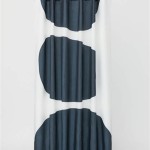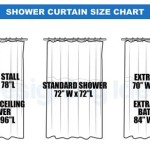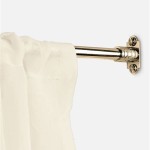Heavy Duty Curtain Rods Without Center Support: A Comprehensive Guide
Curtain rods are essential hardware for hanging window treatments, offering both functional support and aesthetic enhancement to a room. Heavy-duty curtain rods, specifically those designed without center support, offer a robust solution for wider windows and heavier curtains. These rods provide a clean, uninterrupted look, which is particularly desirable for modern and minimalist interior designs. Understanding the specifications, selection criteria, and installation considerations for these rods is crucial for ensuring both their longevity and the safety of the installation.
Traditional curtain rods often rely on a center support bracket to prevent sagging, particularly when used with heavy drapes or across wider spans. While effective, this center support can visually disrupt the flow of the curtain and potentially interfere with the smooth operation of traversing curtains. Heavy-duty rods designed without a center support address this issue by utilizing stronger materials and construction techniques that enable them to span greater distances without bending or breaking.
The absence of a center support provides a sleek, streamlined aesthetic. This is particularly appealing in contemporary spaces where clean lines and minimal visual clutter are prioritized. Furthermore, the lack of a center bracket simplifies the traverse motion of the curtain, allowing for effortless opening and closing, especially important for curtains with grommets or rings. This design choice also streamlines the installation process, albeit with careful attention to proper anchoring and weight distribution.
Key Considerations for Selecting Heavy Duty Curtain Rods Without Center Support
Selecting the appropriate heavy-duty curtain rod without center support involves careful consideration of several factors. These include the material of the rod, the weight capacity, the span length, and the mounting hardware. Each of these elements contributes to the overall performance and longevity of the rod.
Material: The material of the curtain rod significantly impacts its strength and durability. Steel and wrought iron are common choices for heavy-duty applications. Steel offers a good balance of strength and affordability, while wrought iron provides superior strength and a classic aesthetic. Other materials, such as aluminum, may be suitable for lighter applications, but are generally not recommended for heavy drapes across significant spans. The gauge (thickness) of the material is also critical. Thicker gauge steel or wrought iron will offer greater resistance to bending and sagging.
Weight Capacity: The weight capacity of the rod is a critical specification. It is essential to accurately estimate the weight of the curtains that will be hung on the rod. Overloading a curtain rod can lead to bending, sagging, or even complete failure. Consult the manufacturer's specifications for the rod's maximum weight rating, and always err on the side of caution, choosing a rod with a weight capacity that exceeds the estimated weight of the curtains. The weight distribution also plays a role; evenly distributed weight will place less stress on the mounting points compared to concentrated weight in the center.
Span Length: The span length refers to the distance between the mounting brackets. The longer the span, the greater the stress on the rod. Heavy-duty rods are designed to handle longer spans without center support, but there is still a limit. Manufacturers often provide guidelines for maximum span lengths based on the material and weight capacity of the rod. Exceeding these limits can compromise the rod's integrity. Consider the structural support available in the wall when determining the span length. Mounting brackets should ideally be secured to wall studs to provide maximum stability.
Mounting Hardware: The mounting hardware is just as important as the rod itself. The brackets must be strong and securely anchored to the wall. For heavy curtains, it is recommended to use heavy-duty brackets that are designed to support significant weight. The type of wall also influences the choice of mounting hardware. Drywall anchors are generally inadequate for heavy-duty applications; instead, opt for screws that are long enough to penetrate into wall studs or use specialized anchors designed for hollow walls with high weight-bearing capacity. The number of mounting brackets required will depend on the span length and the weight of the curtains. Wider spans and heavier curtains will require more brackets to distribute the load effectively.
Installation Techniques for Maximizing Stability and Load-Bearing Capacity
Proper installation is paramount to ensure the stability and longevity of a heavy-duty curtain rod without center support. Regardless of the quality of the rod and mounting hardware, incorrect installation can lead to failure. The installation process involves careful planning, precise measurements, and the use of appropriate tools and techniques.
Locating Wall Studs: The most secure method of mounting a curtain rod is to attach the brackets directly to wall studs. Wall studs are vertical framing members within the wall that provide structural support. A stud finder can be used to locate these studs accurately. Once a stud is located, mark its position clearly. When aligning the mounting brackets, ensure that at least one screw from each bracket is securely fastened into a stud. This provides a strong and stable anchor point.
Using Appropriate Anchors: If wall studs are not available in the desired location, it is necessary to use wall anchors. There are various types of wall anchors available, each with different weight-bearing capacities. For heavy-duty applications, toggle bolts or molly bolts are recommended. These anchors provide a secure grip on the back of the drywall, distributing the load over a wider area. Follow the manufacturer's instructions carefully when installing wall anchors. Ensure that the anchors are properly sized for the screws being used and that they are fully engaged in the wall.
Ensuring Proper Alignment and Leveling: Accurate alignment and leveling are crucial for both aesthetic and functional reasons. Use a level to ensure that the mounting brackets are perfectly horizontal. Misaligned brackets can cause the curtain rod to sag or appear crooked. Mark the position of each bracket carefully before drilling any holes. Use a pilot hole to guide the screw and prevent the drywall from cracking. Double-check the alignment and leveling before tightening the screws completely.
Distributing Weight Evenly: The way the curtains are hung can also impact the load on the rod. Distribute the weight evenly across the rod by using an appropriate number of curtain rings or hooks. Avoid bunching the curtains in one area, as this can create a concentrated load that can cause the rod to sag. If using grommet-top curtains, ensure that the grommets are evenly spaced along the rod. For pinch-pleat curtains, space the hooks evenly to distribute the weight properly.
Materials and Finishes: Aesthetic Considerations
Beyond structural integrity and load-bearing capacity, the aesthetic appeal of a heavy-duty curtain rod is an important consideration. The choice of material and finish can significantly impact the overall look and feel of a room. Matching the curtain rod to the existing décor and style is crucial for creating a cohesive and harmonious design.
Steel Finishes: Steel curtain rods are available in a variety of finishes, including brushed nickel, polished chrome, oil-rubbed bronze, and matte black. Brushed nickel offers a subtle, contemporary look that complements many interior styles. Polished chrome provides a sleek, modern aesthetic. Oil-rubbed bronze adds warmth and character, making it a good choice for traditional or rustic spaces. Matte black is a versatile option that can work well in both modern and industrial settings. Powder coating is a durable finish option for steel, providing resistance to scratches and corrosion.
Wrought Iron Finishes: Wrought iron curtain rods typically feature a dark, textured finish. Black is a common choice, but wrought iron can also be painted or powder-coated in other colors. The inherent texture of wrought iron adds visual interest and depth to the rod. Wrought iron is often associated with traditional or rustic décor, but it can also be incorporated into modern spaces to create a contrast in textures and styles.
Caps and Finials: The end caps or finials of the curtain rod are small but important details that can enhance the overall aesthetic. Finials are decorative embellishments that attach to the ends of the rod, while end caps provide a simple, clean finish. Finials are available in a wide range of styles, from classic ball shapes to intricate carvings. Choose finials that complement the style of the curtains and the room's décor. End caps are a more minimalist option that is well-suited for contemporary spaces.
Coordinating with Curtain Hardware: When selecting a curtain rod, consider the other hardware that will be used, such as curtain rings, hooks, and clips. Choose hardware that complements the rod's finish and style. For example, if using a brushed nickel curtain rod, opt for brushed nickel curtain rings to create a cohesive look. Ensure that the hardware is also durable and designed to support the weight of the curtains. Cheap or flimsy hardware can detract from the overall appearance and compromise the functionality of the curtain rod.

1 No Drilling Shower Closet Window Tension Rod Heavy Duty 42 72 Antique Gold

Rod Desyne 48 In 84 Heavy Duty Traverse Curtain White 3111 481 The Home

5 Easy Ways To Hang Curtains Without Drilling

Roomdividersnow 48 In 80 Premium Tension Curtain Rod Black Bktr 90 The Home

Custom French Iron Curtain Rod Bestwindowtreatments Com

Rod Desyne 66 In 120 Heavy Duty Traverse Curtain White 3111 661

Great Curtain Rod Options For Patio Doors Designer Drapery Hardware

Ona Brackets For 1 5 8 Dia Heavy Duty Custom Metal Curtain Rod Bestwindowtreatments Com

5 Easy Ways To Hang Curtains Without Drilling

Bypass Curtain Rods Allow Rings To Brackets For Full Opearation








